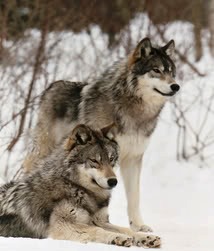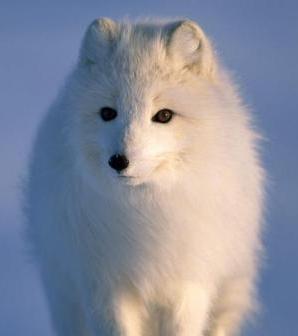Canidae is the biological family of carnivorous and omnivorous mammals that includes wolves, foxes, jackals, coyotes, and domestic dogs. A member of this family is called a canid. Imagine a typical canid for just a second. You probably think of a dog or wolf right? As it turns out there are about 35 species of canids in 13 genera. They include domestic dogs, wolves, foxes, coyotes, dingos, dholes, and jackals.
The Canidae family is divided into two tribes: Canini (related to wolves) and Vulpine (related to foxes).
Fox is a name applied to any of roughly 27 species of small to medium-sized canids, characterized by possessing a long, narrow snout, and a bushy tail, or "brush". The presence of fox-like carnivores all over the globe has led to their appearance in the popular culture and folklore of many nations, tribes, and other cultural groups
Most canids are solitary animals, hunting alone; however, there are four species, the Wolf, African hunting dog, Asian dhole, and the bush dog, that form packs. It is believed that humans and wolves engaged in cooperative hunting rituals around 15,000 years ago. This cooperation soon led to the domestication of the dog.
With few exceptions, canids forage for small game animals, like rabbits, squirrels, or small birds. Larger canids have been known to hunt elk, deer, and even moose. Jackals eat carrion on the African plains. The bat-eared fox eats large amounts of insects. Occasionally canids will even eat vegetable matter, although this is rare. In Alaska there are five types of canines. They include the domestic dog, arctic fox, red fox, coyote, and gray wolf.
Gray Wolves are social animals and usually live in packs that include parents and pups of the year. The average pack size is six or seven animals, and pack members often include some yearlings and other adults. Packs of 20 to 30 wolves sometimes occur, and these larger packs may have two or three litters of pups from more than one female. The social order in the pack is characterized by a separate dominance hierarchy among females and males. In most areas wolf packs tend to remain within a territory used almost exclusively by pack members, with only occasional overlap in the ranges of neighboring packs. Alaska is home to an estimated 7,000 to 11,000 wolves. Wolves have never been threatened or endangered in Alaska.
The coyote, like the wolf, is a member of the dog family (Canidae) and resembles a medium-sized shepherd-collie type dog. Distinctive features of the coyote are its sharp pointed ears that never droop, a sharp pointed nose, and long bushy tail. The legs of the coyote are generally slimmer and the feet smaller than those of a dog of comparable size. The coyote may be the most vocal of the canids and is sometimes referred to as the “song dog.” The most common call is a long, mournful high-pitched howl which ends in a series of sharp yips and yaps.
The red fox has the appearance of a small dog and weighs from 10 to 15 pounds and measures up to 2 feet long with another foot for a bushy tail. The end of the tail is black, tipped with white. The Red Fox is most commonly a rusty red, with white underbelly, black ear tips and legs, and a bushy tail usually with a distinctive white tip. The "red" tone can vary from dark chestnut to golden. Because the gray fox frequently has quite a lot of red hair, it may be confused with the red fox. The red fox is essentially a nocturnal animal, but it occasionally feeds during the day, and more at dawn and dusk.
The arctic fox is found in treeless coastal areas of Alaska from the Aleutian Islands north to Point Barrow and east to the Canada border. Both blue and white color phases occur, with the blue phase more common on the Aleutian and Pribilof Islands. The white color phase is more common in northern populations. Young of each color phase may occur in the same litter.Fully grown arctic foxes weigh from 6 to 10 pounds. They average 43 inches in length including the tail, which is about 15 inches long. Their short legs and body, short ears, and dense winter fur give them a stocky appearance compared to their relative, the red fox..
The Alaskan Malamute, as the name suggests, originates from Alaska, and was developed for pulling sleds and drafting. These dogs were also used for hauling and hunting in larger numbers. These working dogs were first registered with the AKC in 1935. Perhaps one of the most undisputed facts about the Alaskan Malamute is that he is one of the most unaltered breeds found today. They are descendants of dogs that lives with the Mahlemut Tribe that was located in upper portions of western Alaska. These were very distinctive and necessary animals and often were just as important to the people in their area. They helped with virtually all facets of life including hunting and working with them as well as living with them.
|
|







